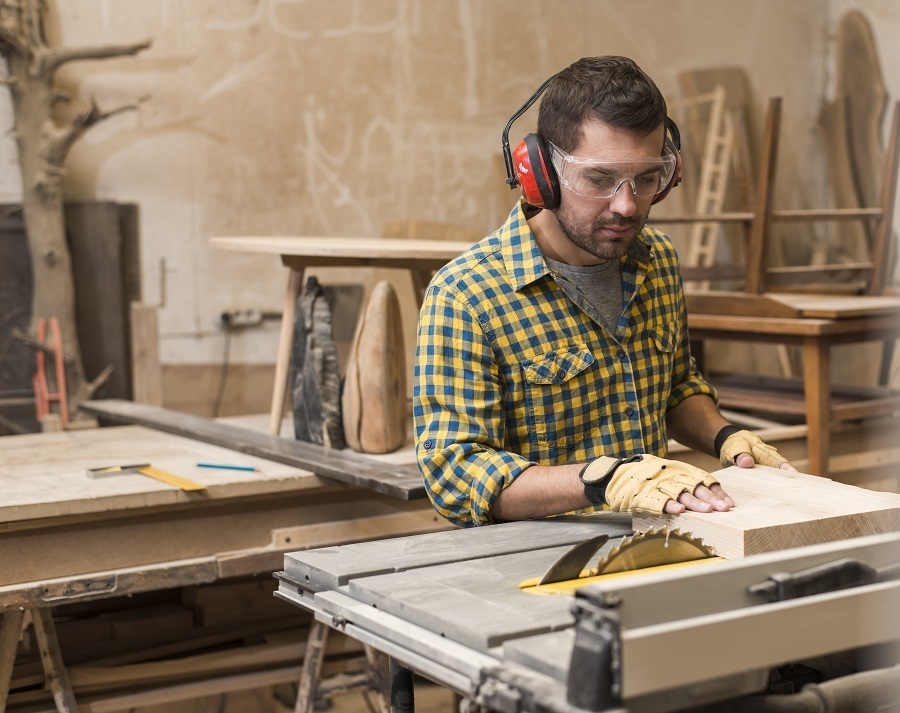Last updated on
Want to take on a little woodworking project that involves power tools? A table saw is an important tool in a woodworker’s toolset but it is just as important to handle it safely. Here 11 precautions you have to always take.
The table saw is one of the most powerful wood tools known in the industry. Handling it requires full knowledge of its parts — the nitty-gritty and other basic details. Users, for safety’s sake, are to learn all these.
Before anything else, allow us to stand clear on our claim: all power tools require safe handling. You cannot take to chance safety, accuracy, and efficiency in woodwork.
Safety and efficiency through the table saw are to be carefully calculated if success is truly your aim. This couldn’t get any more realistic with the fact that the table saw is a power tool. One wrong and tentative handling of the tool not only yields wasted effort but also dangerous consequences.
According to a recent statistical claim, a table saw accurately cuts across 2,700 pieces of wood per second. Now, just imagine the force of its teeth. Not only are its teeth sharp and rapid, but they’re also designed to clutch into the surface. The characteristic of its RPM alone warrants the utmost care and caution at work. In addition to that are reports of injury at work:
What's Inside
Table Saw Safety Rules

For your own safety, here are some quick tips on how to safely use the table saw:
Clear the Area of All Obstacles
Besides the fact that the scattered wood pieces, sawdust, etc. initially hinder smooth sawing flow, they also potentially wind up as projectiles. More so, these obstacles block your stance and/or position, further endangering you to fall face-front into the motor. God forbid!
Don’t Replace Blades When the Power is Still Connected
This is a golden rule. Always consider that the table saw can potentially turn on anytime when the power is connected.
So, make it a habit to always disconnect it when replacing the blades.
Also, replacing the blades requires that you dip your whole hands into the machinery’s interior. That alone spells potential danger.
Focus on What You’re Cutting
Do not ever lose sight of the real work. If you can slack off and zone off a bit in your mundane task, well, not in this. The table-sawing task, regardless of manual or machine presence, requires absolute concentration and attention to work.
One wrong placement of the wood or position of your hand leads to disaster. Besides, woods are expensive. So, you wouldn’t want to waste a good lumber or two.
Securely Fence Your Table Saw Before Cutting
Don’t ever proceed with a rip cut without securing a rip fence firsthand. The rip fence guides your woodblock to a pattern parallel to the running blade.
Without the rip fence, you’ll generally expose your hand to cuts, kickbacks and possible contact with blunt force.
Moreover, a rip fence stabilizes the wood block’s position despite rapid movement of the motor.
Always Wear Eye and Ear Protection Before Cutting
This is of course a universal protocol. One cannot be too confident on the job.
Things happen on site, and you simply cannot expose your sensitive eyes and ears to untoward incidents.
Put on a Special mask to Protect Your Face Should Sawing Be Dusty
The cutting operation is expected to yield minute dust — saw and other forms of dust — that potentially harm your face. Wearing a face mask shields your face from the dust.
Perhaps, with the trusted presence of the mask, you may no longer have to separately wear eye and ear protective gear.
Inspect the Table Saw, Its Manuals, and Safety Features
Know which parts and features of the table saw you can prepare for future emergencies.
By identifying the safety features, you also get the hang of the best table saws.
Stand Properly When Feeding the Saw
The right posture. This should secure you a safer working environment involving table saws. Being tentative on your posture exposes you to immediate danger. The consequences include falling into the motor, slipping, dropping wood blocks into your feet, etc.
Only Feed and Dry and Ripe Wood to the Machine
Before you even decide to cut wood, secure the quality of the wood. Most of the time, non-flat and raw wood catches succumb to projectile and kickbacks.
Most importantly, wet hardwood is hard to cut, further causing the rivet knife to lose momentum.
Use a Stable Stand When Working on Heavy Plywood
Working with heavy plywood can be difficult if you don’t have any stable stand to support it. If you place/lean the plywood into the stand, chances are you’ll be able to cut it with least to zero errors.
The outfeed table, for instance, provides strong support to the plywood. More so, it keeps the plywood from sliding off. The outfeed table is easier to assemble on your own. Thus, it’s highly recommendable.
Get Rid of Those Gloves
If you think it’s safer to wear gloves while working on the table saw, think again. Gloves are a magnet of disaster when worn on sawing duty. For one thing, they make you lose your grip. Most importantly, gloves, especially the loose ones, can get snapped by the running blades.
The Takeaway
Woodworking efforts constantly see injuries as a tailing consequence. This is strongly due to the table saw’s rapid motion and cutting power. Thus, a table saw is constantly referred to as a power tool. In fact, experts consider it to be one of the most powerful wood tools in the industry.
Handling the table saw requires prudence and caution from the user. By all means, it requires to be handled/operated by a professional woodworker. If you lack the knowledge in handling it, or if you’re only handling it for the first time, better ask for assistance.
Fortunately, through some practical tips on how to safely use a table saw, we can only hope for a safe and efficient wood-working environment for our readers.




